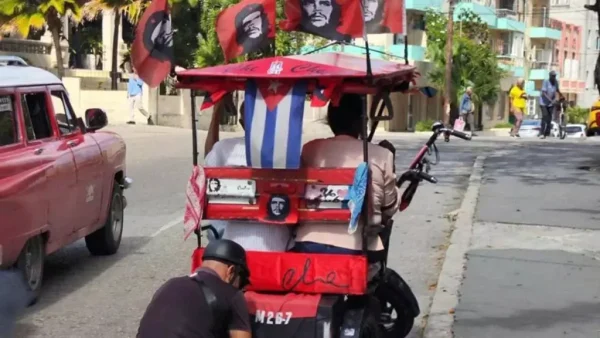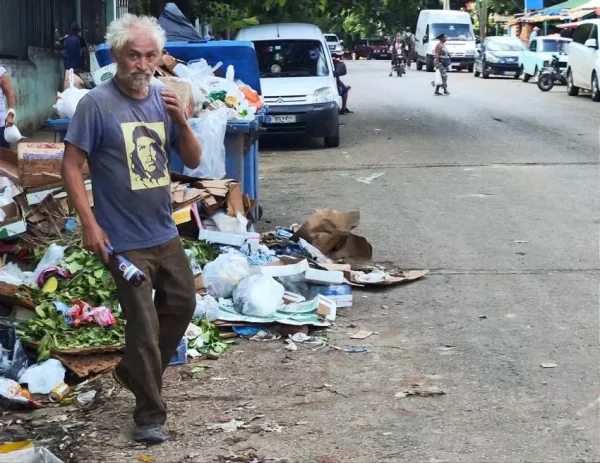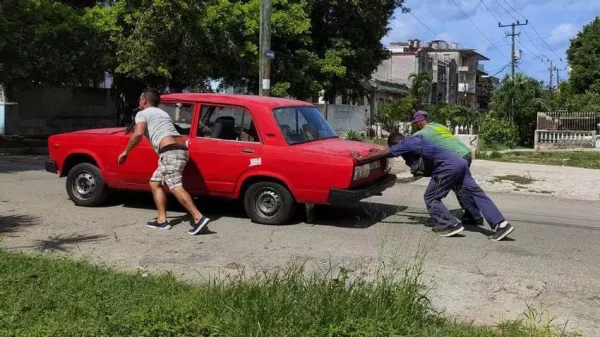Che Now Has Someone Who Overshadows Him

Vigils for El Taiger overshadow the official tribute to Che Guevara on the 57th anniversary of his death.
By Juan Diego Rodriguez and Juan Izquierdo (14ymedio)
HAVANA TIMES – The pedicab travels through the streets of Havana with more Castro talismans than a May Day parade. It is of little use. The weight of the passengers, who are putting their backs against a banner of the 26th of July, plus that of the driver – the architect of the revolutionary float – soon causes the vehicle to collapse. To diagnose the damage, the tricycle makes a forced landing next to the curb.
Whether it was the loose chain or a puncture, no one knows: the fact is that the Heroic Guerrilla brought little luck to the journey. Five red flags with the face of Che flutter above the roof while, in a bad mood, the driver lowers his head to the chassis. His two customers do not flinch. They paid for the trip, not to show solidarity with the proletariat.
Guevara’s nickname, written over and over again in dubious handwriting on the bicycle taxi, makes it seem at times like a tribute to the cha-cha-chá. The driver, in fact, moves from one side to the other trying to detect the fault, but the carcass remains motionless. Two colorful handkerchiefs, on the port and starboard sides, complete the message: they represent the guapería [swagger], another “revolutionary” value that Miguel Díaz-Canel himself has praised. “I love Cuba” is the final slogan, an affection that the scene makes it more than difficult to share.
“Let’s go,” the driver finally says, and pedals off. Above his head, another “saint’s picture”: the umpteenth reproduction of Korda’s portrait of Che, which acts as a figurehead on the bicycle taxi.

On October 8, along with the usual, tasteless tributes that the official press pays to the Argentinean who died in 1967, the most unusual characters are wearing Che Guevara T-shirts. This is the case of one of the dumpster divers who frequents the garbage dumps in Havana’s Key West neighborhood. One must be a “heroic guerrilla” to, like the old man is doing now, rummage through the garbage in search of food.
In his mind there is no cause-effect relationship between the regime that Guevara helped to establish and his misery. Like many other “faithful” people, he thinks that if Cuba is full of piled up garbage everywhere it is not because of Che or Fidel, but because of more abstract causes: the ‘blockade’, the situation or the circumstances. With Guevara’s face on his chest, the beggar kneels in the trash to earn his lunch: at least on the symbolic level, both faces see the same rot.

Not far from there, another vehicle – a Lada, also red from the hood to the windshield – is fighting paralysis and breakdowns. It is a Prensa Latina car, the agency through which Che dreamed of bringing the truth, his and Castro’s, to the entire continent. Leaning in through the front door, in shorts, with a cigarette in his mouth and his belly visible, the driver – together with a mechanic and another passenger – pushes the Lada.
In Havana on October 8, where there is no shortage of scenes like these, Fidel’s words about Guevara in 1987 – which were being retweeted by dozens of leaders, including Díaz-Canel – sound ironic: “If a paradigm is needed, if a model is needed, if an example to imitate is needed to reach such lofty goals, men like Che are essential.” But reality does not promise anything. The “initiation” of a small group of children, the ‘pioneers’ who received their blue scarves on Tuesday, contrasts with the lively vigils for the health of El Taiger, who is dying after being shot in Miami.

Cubans do not aspire to be like Che, but rather like the repartero, the reggaeton singer. Although the official position has been to condemn the attack on El Taiger, the author of Washypupa and Me quemaste, many leaders have regretted that young people do not pay homage with the same fervor to the guerrilla or to the victims of the attack on Cubana flight 455, coming from Barbados, on October 6, 1976.
But these are no longer the days of “Pioneers for communism, we will be like Che.” Now we have the words of El Taiger, whose lyrics – and who would have repeated them to the regime – are not lacking in lucidity: “Your story is badly told / And nobody believes you.”
Editor’s Note: Two days later, El Taiger died in a Miami hospital, unable to recover from a shot to his head.





